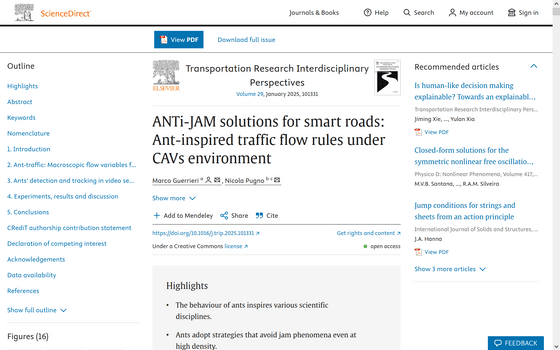It is clear that ants are prohibited from overtaking and move at a constant speed to smooth traffic flow

As the term 'ant procession' suggests, ants move in a line, following the ant in front of them. A civil and environmental engineering specialist has discovered how procession ants are able to move in an orderly fashion without bumping into each other or leaving any gaps between them.
ANTi-JAM solutions for smart roads: Ant-inspired traffic flow rules under CAVs environment - ScienceDirect

Traffic jams? Study reveals ants' secrets to smooth traffic flow
Marco Warriors of the University of Trento and his colleagues noticed that ant queues form queues similar to those of cars on the highway, and speculated that a traffic control system inspired by ant behavior could be used to avoid the risk of congestion even in heavy traffic. They filmed the queues of ants on video to investigate how the ants move.
Below is a photo of the ant procession taken by the Warriors.
Traffic jams? Study reveals ants' secrets to smooth traffic flow - YouTube
Warriors and his colleagues used an algorithmic, deep learning-based approach to detect, track and classify ants in the video using techniques such as neural networks. This analysis allowed them to track the movements of individual ants and map their trajectories, speed, flow and density.

As a result of the analysis, it was found that unlike a motorcade, a procession of ants rarely gets 'clogged'. The main reasons for not getting clogged are that they 'move at a nearly constant speed,' 'use multiple routes,' and 'do not overtake,' Warriors and his colleagues speculated.
In particular, the 'no overtaking' feature was quite noticeable; although one ant might stray from the route and be overtaken by the ant behind it, the ants walking side by side never tried to force their way past the ant in front of them.
They also found that the ants formed multiple 'platoons' and coordinated their walking speeds within the formation. On the other hand, when solitary ants sensed the strong pheromones emitted by the leading platoon, they moved faster to catch up with the formation.

Warriors and his team proposed applying ant behavior to automobiles, saying, 'We think that ant behavior can be applied to 'cooperative self-driving cars' that communicate with other cars and roads to drive smartly. Cars could share information with each other in the same way that ants exchange pheromones, keep each vehicle's speed constant, set the vehicle speed to a value equal to the maximum speed allowed on the highway, and reduce the average distance between vehicles to artificially form a platoon.'
Related Posts:







